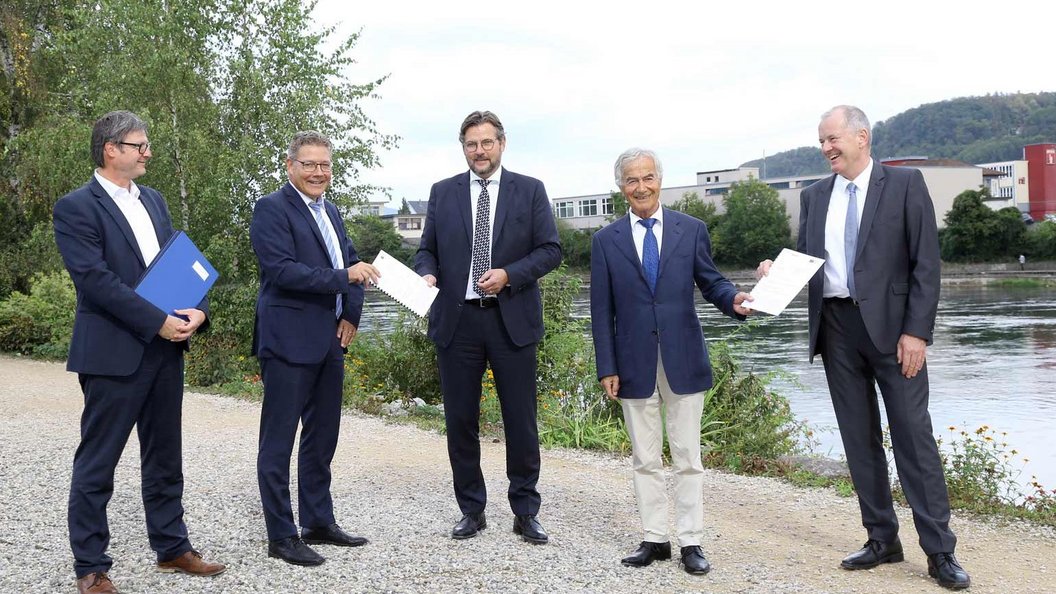Contacto
Media Relations
T: +41 58 833 83 33
media@alpiq.com
Lausanne/Solothurn/Aarau – Alpiq’s Gösgen hydropower plant has been granted a new concession for 70 years. The new concession was signed on 23 September 2020 by the governments of the two cantons of Solothurn and Aargau as well as representatives of Alpiq, as the concession holder, and took effect retroactively from 1 January 2020. Over the coming years, Alpiq will invest CHF 63 million in the largest run-of-river power plant on the River Aare – thus making an important contribution to climate-friendly electricity generation and the security of supply in Switzerland.

The current concession for Alpiq’s Gösgen hydropower plant and the Winznau weir is valid until 2027. Since the Winznau weir requires comprehensive refurbishments, the Swiss cantons of Solothurn and Aargau, the grantors of the concession, and Alpiq Hydro Aare AG, the current concession holder, entered into negotiations regarding an early renewal of the concession for a period of 70 years.
These efforts have now come to a successful conclusion: On Wednesday, 23 September 2020, the relevant cantonal councillors Roland Fürst (canton of Solothurn) and Stephan Attiger (canton of Aargau) officially enacted the concession in Niedergösgen with retroactive effect from 1 January 2020. This enactment was preceded by the official acceptance of the concession by the representatives of Alpiq Hydro Aare, Chairman of the Board of Directors Walter Straumann and CEO Thomas Fürst.
“The promotion and safeguarding of domestic renewable and thus resource-conserving electricity generation by means of hydropower is of key importance,” explained Solothurn’s Director of the Construction and Justice Departments, Roland Fürst, during the signing of the concession. “Thus, we are delighted that thanks to the renewal of the concession and Alpiq’s investments, the Gösgen hydropower plant will continue to generate environmentally friendly electricity for the next 70 years.”
“Hydroelectric power plays a central role in ensuring our security of supply with electricity,” said Stephan Attiger, a government councillor of Aargau. “This requires substantial, long-term investments. The Canton of Aargau thanks Alpiq for its entrepreneurial decision to maintain hydropower,” Stephan Attiger said.
The new concession will apply for 70 years, i.e. until the end of 2089. Thus, the Gösgen hydropower plant will continue to make an important contribution towards the environmentally responsible and climate-friendly generation of electricity and the security of supply in Switzerland over the coming decades. During the ratification of the concession in Niedergösgen, Michael Wider, a member of Alpiq’s Executive Board and Head of the Generation Switzerland business division, emphasised the importance of this step for Alpiq: “The exemplary and pioneering new concession for the Gösgen hydropower plant and the continuation of the partnership with the cantons of Solothurn and Aargau represent a milestone for us. We are proud to continue the pioneering project, which began in Gösgen in 1917, for another 70 years.”
Over the next few years, Alpiq will invest a total of more than 63 million Swiss francs in environmentally friendly hydroelectric electricity generation at the Gösgen hydropower plant. This includes some CHF 12 million for the implementation of a total of 21 compensation and offsetting measures. With the implementation of these measures, the environmental footprint of the hydropower utilisation at the Gösgen hydropower plant will be significantly improved in line with the Federal Act on the Protection of Nature and Cultural Heritage. Fish migration, for example, will be improved in an ecologically exemplary manner thanks to increased water discharge into the revitalised old Aare, a new fish bypass at the engine house in Niedergösgen and the removal of the Bally weir.
The Gösgen hydropower plant was constructed between 1913 and 1917. Between 1996 and 2000 the engine house was completely restructured. The largest run-of-river power plant on the River Aare has an average annual output of 300 million kWh, which corresponds to the annual consumption of some 75,000 households. The power plant utilises the gradient of the River Aare over a stretch of around 14.5 kilometres – from the Aare Bridge near the town of Aarburg to a point 250 metres upstream of the road bridge near the village of Schönenwerd. 93 percent of this stretch runs through the canton of Solothurn, 7 percent through the canton of Aargau. The two cantons share in the revenue from the granting of the concession in the same proportions.